Scenic Naksansa Temple
in Yangyang County
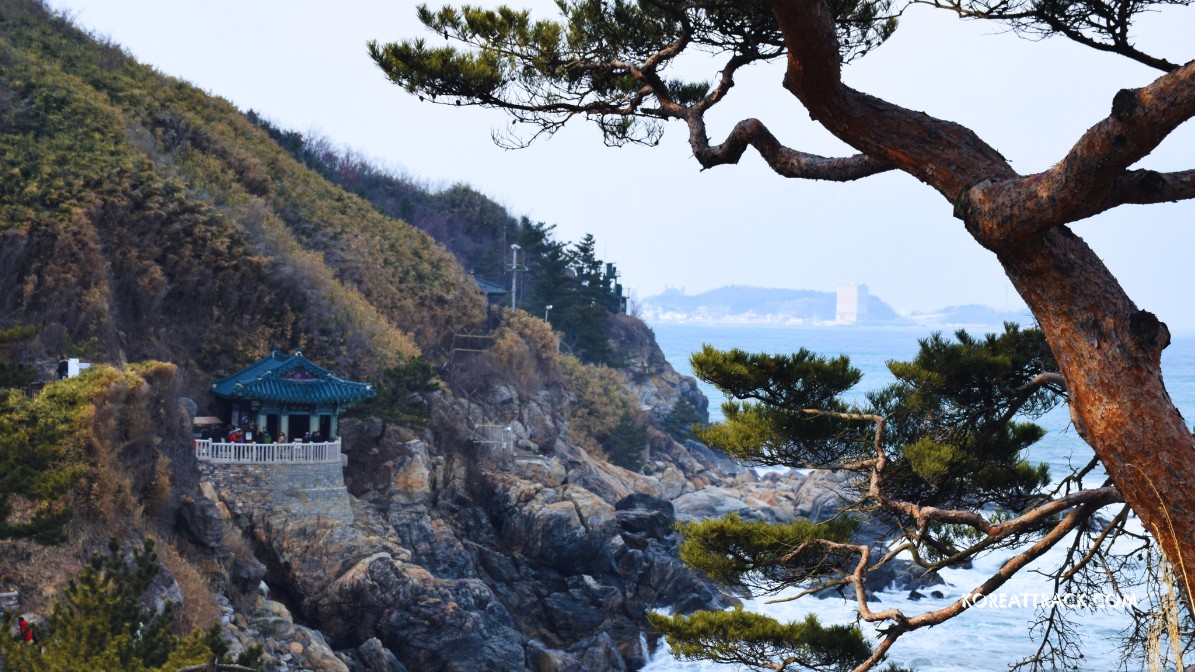 Naksansa Temple in Yangyang is one of the Eight Scenic Views in Gwandong
Naksansa Temple in Yangyang is one of the Eight Scenic Views in GwandongNaksansa Temple in Yangyang
Naksansa Temple (낙산사) is a Korean Buddhist temple complex located on the slopes of Naksan Mountain (also known as Obongsan Mountain).
It is about midway between Sokcho and Yangyang in Gangwon Province, in the eastern region of South Korea.
This beautiful temple complex houses many cultural treasures and is known for its stunning natural surroundings. This article will explore some critical details about Naksansa Temple, including its history, architecture, and notable features.
History
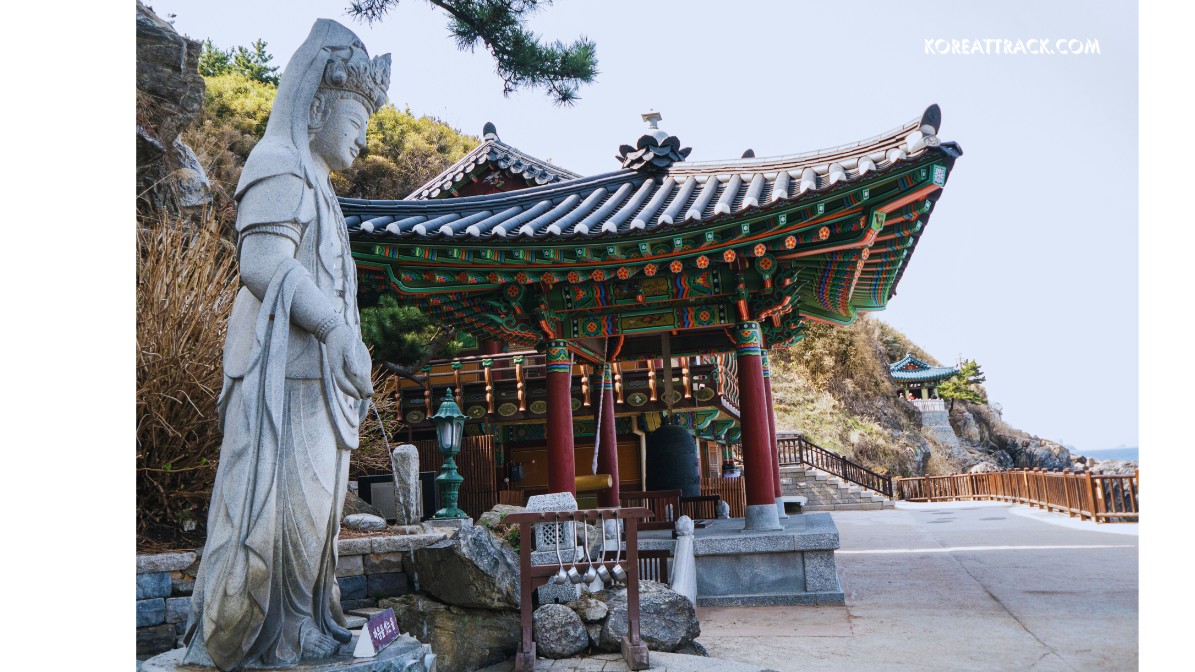 Naksansa Temple in Yangyang
Naksansa Temple in Yangyang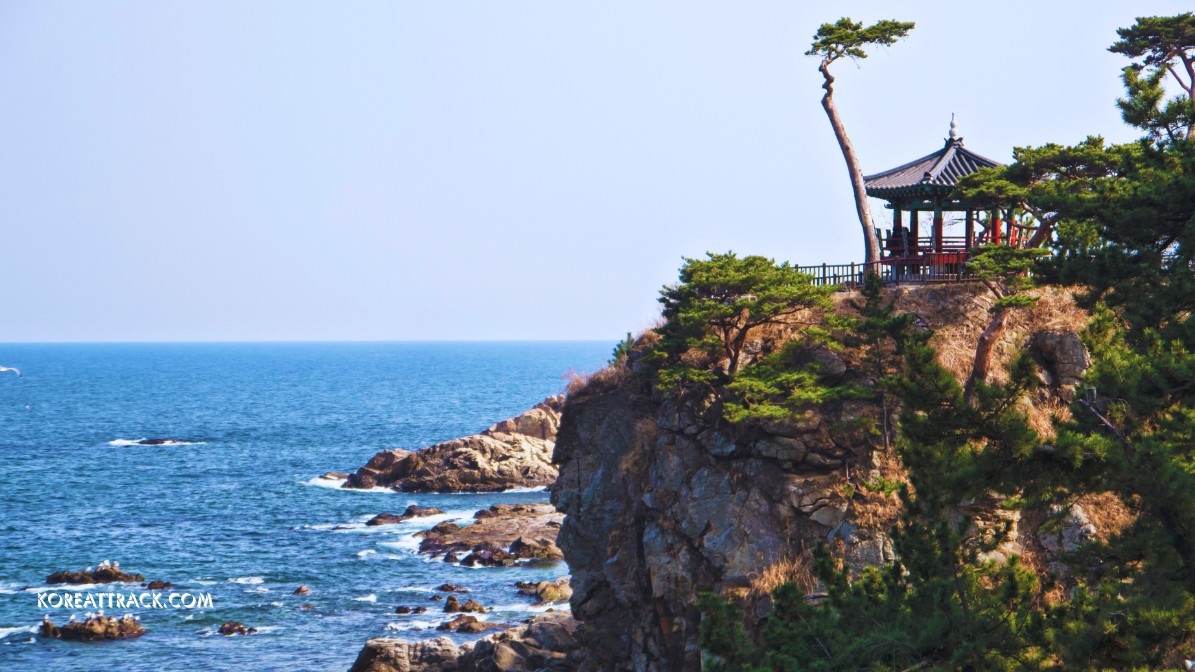 Naksansa Temple in Yangyang - Pavilion
Naksansa Temple in Yangyang - Pavilion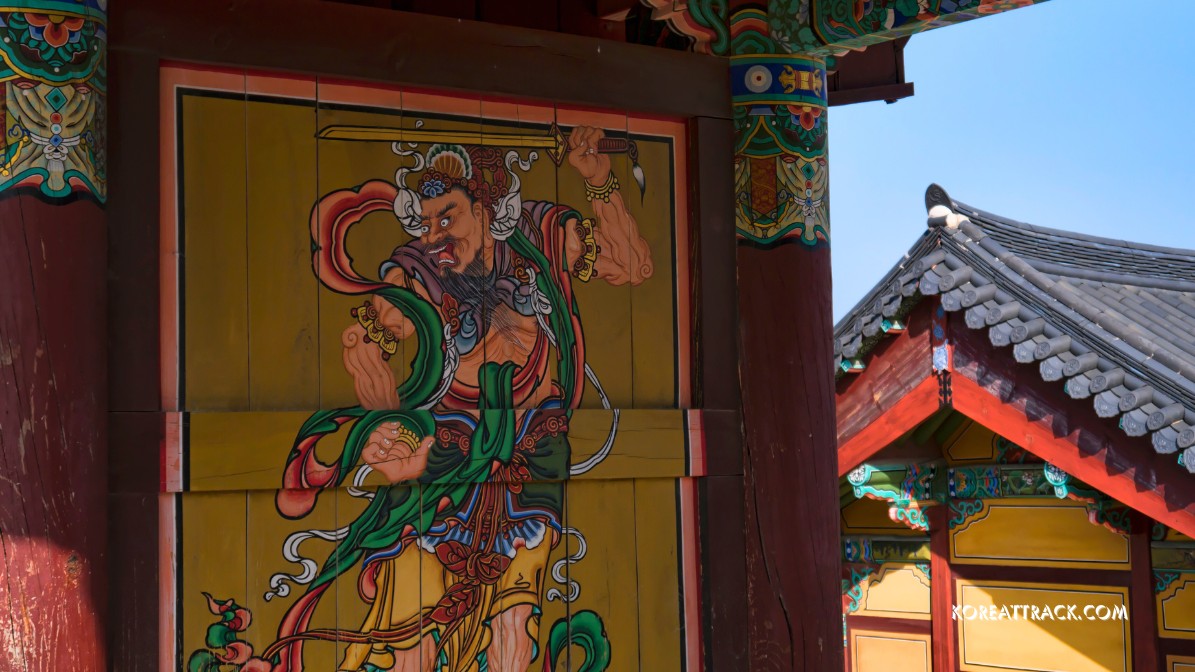 Naksansa Temple in Yangyang - Warrior god painting
Naksansa Temple in Yangyang - Warrior god paintingNaksansa is a historic Buddhist temple in Yangyang County, Gangwon Province, South Korea.
It was founded in 671 by Uisang Daesa, a prominent Buddhist monk and ambassador of the 30th King Munmu of the Silla period.
After returning from studying abroad during the Chinese Tang dynasty, Uisang established the temple while meditating near the cave where the Avalokitesvara Bodhisattva (Gwaneumbosal) was believed to have lived.
The temple complex is situated on a hill overlooking the East Sea and is surrounded by beautiful natural scenery.
The main hall, known as the Daeungjeon, is a beautiful wooden building that houses a statue of Buddha and other statues and images. The entrance is adorned with intricate carvings and paintings that depict Buddhist teachings and legends.
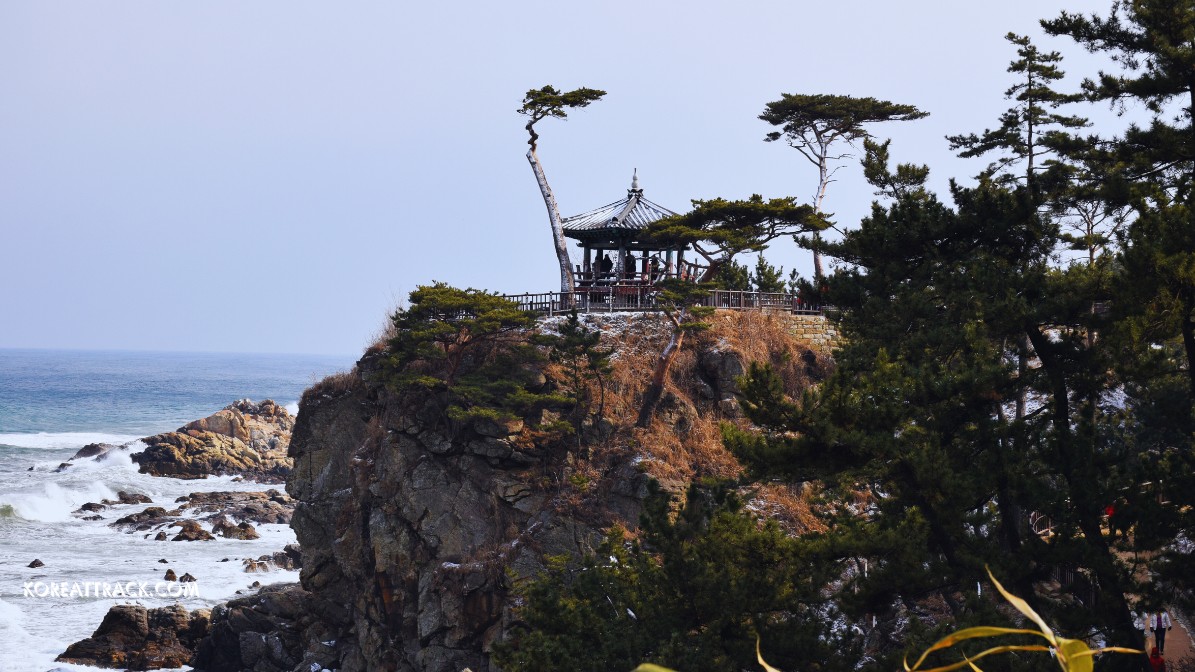 Naksansa Temple in Yangyang. This pavilion was built where Monk Uisang was believed to have received the message to build the temple.
Naksansa Temple in Yangyang. This pavilion was built where Monk Uisang was believed to have received the message to build the temple.One of the most notable structures in Naksansa is the octagonal Uisangdae Pavilion, built in 1925.
It stands where Uisang once meditated and received a divine message instructing him to build the temple there. The pavilion is a popular spot for visitors to take photos and enjoy panoramic views of the sea and the surrounding mountains.
In addition to the main hall and the Uisangdae Pavilion, the temple complex includes many other buildings and structures, including a bell tower, a pagoda, and a museum.
The museum houses a collection of Buddhist artifacts and relics, including statues, paintings, and scriptures.
Naksansa is a must-visit destination for anyone interested in Korean Buddhist history and culture. Its serene setting, beautiful architecture, and fascinating history make it unique and special.
Features and Attractions
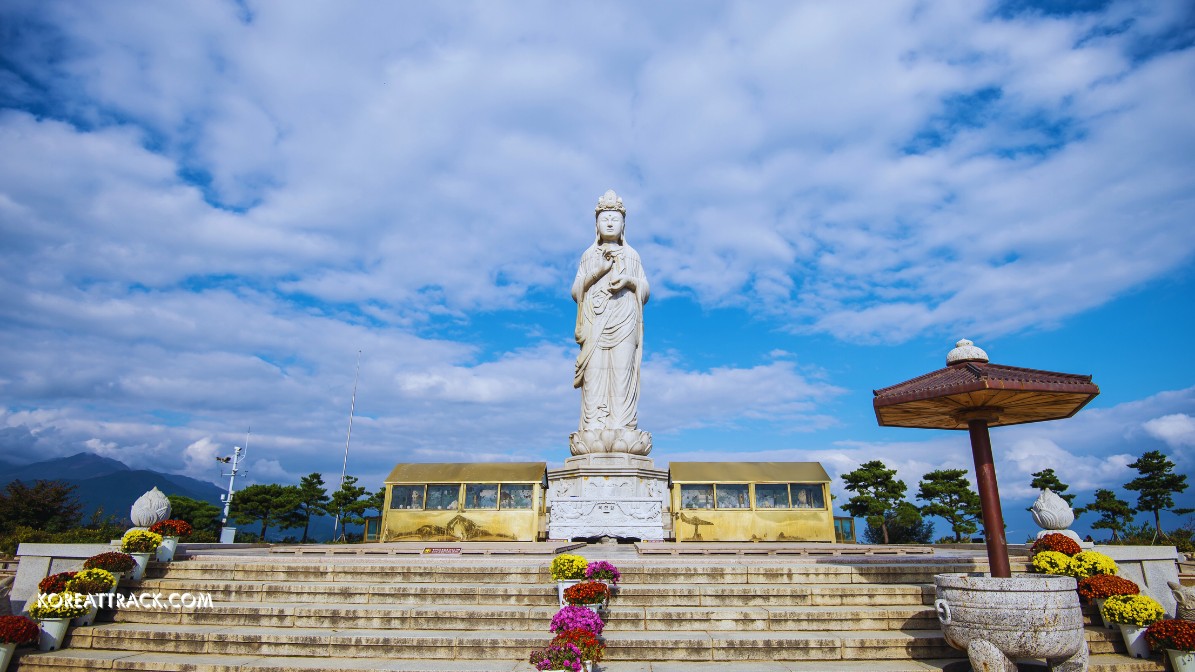 Haesugwaneumsang (해수관음입상, Bodhisattva of Mercy)
Haesugwaneumsang (해수관음입상, Bodhisattva of Mercy)Haesugwaneumsang
Haesugwaneumsang (해수관음입상, Bodhisattva of Mercy) is a famous Buddhist statue and one of the attractions in the temple complex.
Also known as the goddess Gwanseum-Bosal, this impressive white granite statue stands 15 meters (49 feet) high on a 2.8-meter (9.2 ft) pedestal.
The statue faces southeast, gazing out to sea in peaceful meditation. Visitors can climb to the temple complex to see the statue and enjoy the stunning views of the surrounding area.
Hongreanam
Hongreanam is a hermitage in the temple complex. It was built above a stone cave by Uisang, a famous Buddhist monk, in the 9th century.
The hermitage is known for its beautiful scenery, particularly the views of the nearby mountains.
Visitors can hike to the hermitage and enjoy the peaceful atmosphere and stunning views.
The sanctuary floor is a unique feature of some temples in South Korea. It has a 10-centimeter (4-inch) opening through which visitors can see the sea below.
This opening represents the Buddhist belief in the interconnectedness of all things, as it allows visitors to see the sea and the sky while they meditate or pray.
Visitors can experience this unique feature and contemplate nature's beauty while reflecting on their spiritual journey.
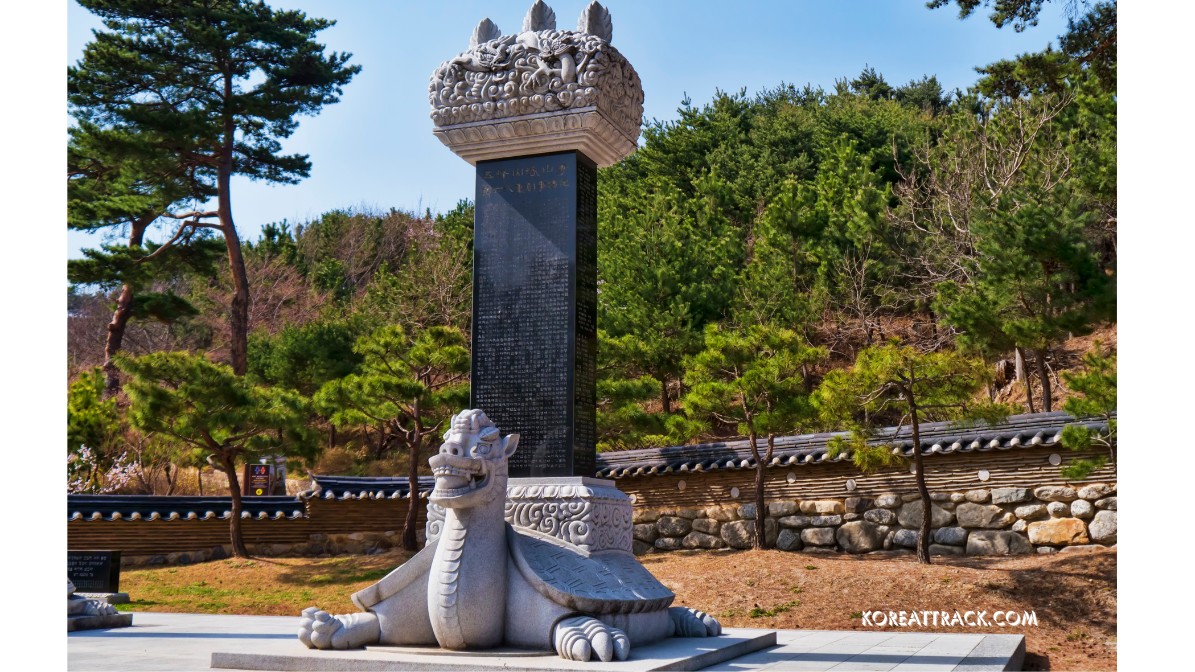 Naksansa Temple in Yangyang - Buddhist steel with inscriptions atop the turtle carving
Naksansa Temple in Yangyang - Buddhist steel with inscriptions atop the turtle carvingNaksansa's Seven-Storied Stone Pagoda
Naksansa's Seven-Storied Stone Pagoda is famous in South Korea. It was constructed in 1467, during the reign of King Sejo, and is considered a national treasure (Treasure No. 499).
The pagoda is made of stone and has seven stories. It contains a Buddhist rosary and a magic bead sealed inside during repairs.
Visitors can explore the pagoda and learn about its history and significance.
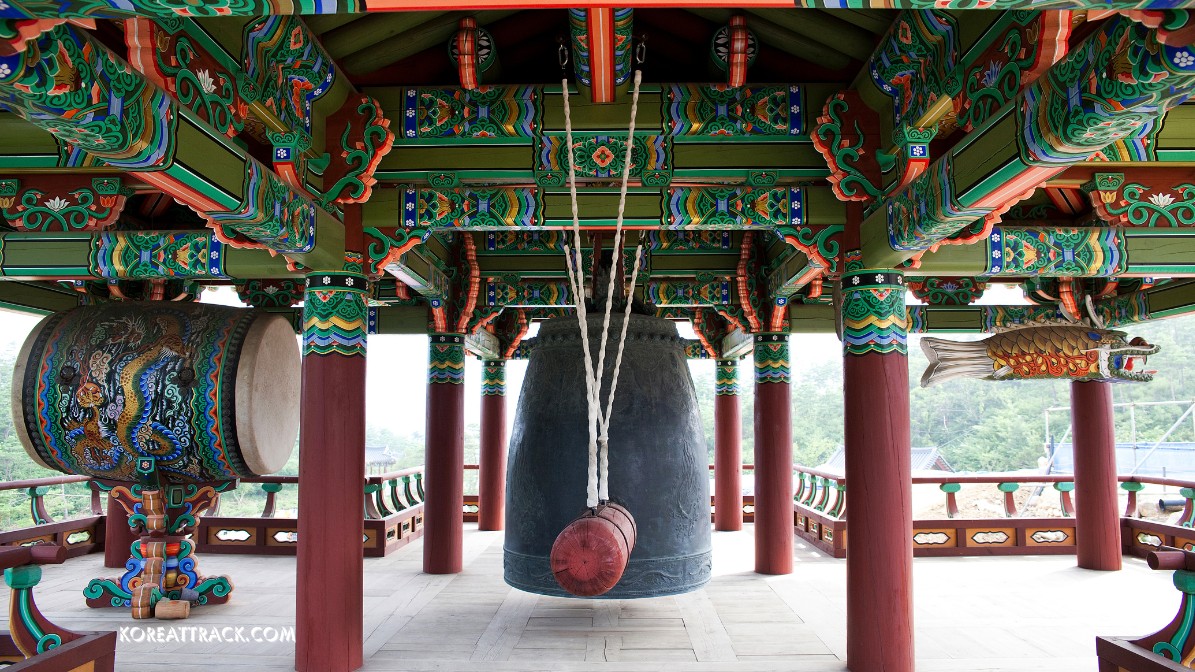 Naksansa Temple in Yangyang - Bell Pavilion
Naksansa Temple in Yangyang - Bell PavilionMount Naksan
Mount Naksan, also known as Korea's Mount Potalaka, is a beautiful and culturally significant site in South Korea.
Its name "Naksan" is an abbreviation of Botarakgasan (補陀洛伽山) in Korean, which refers to Mount Potalaka. According to legend, this is where the Avalokitesvara Bodhisattva and guardian dragons reside.
The temple is part of the "Gwandong Palgyeong," a collective name for the eight most scenic areas in the eastern region of Korea.
Naksansa attracts visitors from all over the world who come to explore its beautiful architecture, serene surroundings, and the majestic Haesugwaneumsang statue.
The temple offers a glimpse into Korea's rich Buddhist heritage and provides a peaceful retreat for those seeking solace and reflection.
If you want to know more about Naksansa Temple, you can visit its official website to learn about its history, events, and visitor information.
If you are a tourist or a local, a visit to Naksansa is a must for you to experience the spiritual and cultural beauty of South Korea.
Events and Rituals at the Naksansa Temple
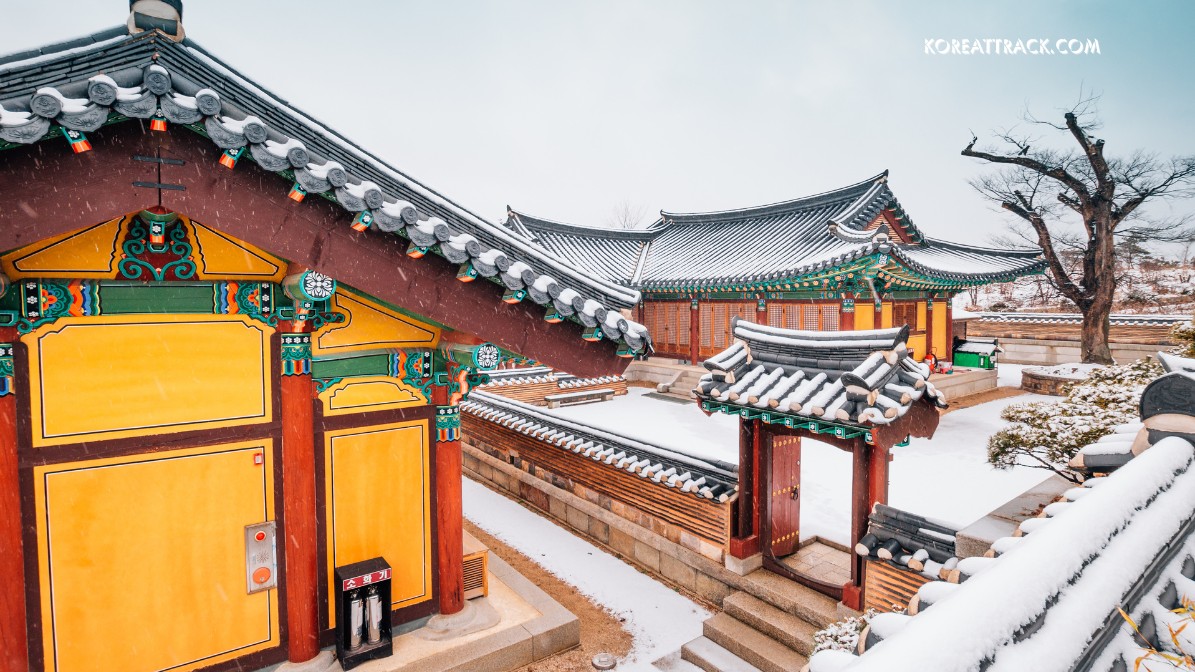 Naksansa Temple in Yangyang during winter
Naksansa Temple in Yangyang during winterNaksansa Temple hosts various rituals and events throughout the year, enriching the spiritual experience for visitors. Here are some notable ones:
Buddha's Birthday (Seokga Tansinil)
Buddha's Birthday, also known as Seokga Tansinil, is a significant festival celebrated on the eighth day of the fourth month in the lunar calendar, which typically falls in May.
The festival is a vibrant celebration where temples come alive with colorful lanterns, traditional performances, and ceremonies.
Visitors can participate in the lotus lantern parade, enjoy a wide range of activities, and witness the illumination of countless lanterns, symbolizing enlightenment.
 Naksansa Temple in Yangyang - drinking fountain
Naksansa Temple in Yangyang - drinking fountainYeongsanjae (Lotus Lantern Festival)
Yeongsanjae, also known as the Lotus Lantern Festival, is held annually in spring. Devotees gather to pray for peace and well-being.
The Yeongsanjae ritual involves chanting sutras and offering lotus lanterns to the Buddha.
The festival is spectacular, with countless illuminated lanterns adorning the temples and streets.
Jijangje (Jijang Bodhisattva Ritual)
Jijangje is a ritual that honors Jijang Bodhisattva, the compassionate bodhisattva who helps guide souls to enlightenment.
The ritual is held on the fifteenth day of the seventh month in the lunar calendar, usually in August.
During Jijangje, devotees make offerings and pray for the deceased, seeking blessings and peace for their loved ones who have passed away.
Seokjeon Daeje (Buddha's Enlightenment Day)
Seokjeon Daeje, also known as Buddha's Enlightenment Day, commemorates the day Siddhartha Gautama attained enlightenment under the Bodhi tree.
The festival is celebrated on the eighth day of the twelfth month in the lunar calendar, typically in December.
On this day, devotees meditate, reflect, and express gratitude for the teachings of Buddhism, seeking spiritual insight and inspiration.
Winter Solstice (Dongji)
Winter Solstice, also known as Dongji, is celebrated on the twenty-second day of the twelfth month in the lunar calendar, typically around December 21.
Devotees gather to pray for health, longevity, and blessings, seeking to overcome the challenges of winter and embrace the new year with renewed energy and hope.
Traditional rice cake soup (tteokguk) is often served during the festival.
Regular Rituals & Practices
 Naksansa Temple in Yangyang
Naksansa Temple in YangyangMorning and Evening Chanting
Monks and nuns gather to chant sutras in the morning and evening.
Chanting is a form of meditation that helps practitioners to focus their minds and cultivate inner peace and tranquility.
108 Prostrations
Devotees perform 108 prostrations as a form of meditation and purification.
Prostrations are a physical expression of reverence and devotion to the Buddha, seeking to purify the body and mind and cultivate spiritual virtues.
Temple Stay Programs
Temple stay programs offer visitors a unique opportunity to immerse themselves in temple life, participate in meditation sessions, and learn about Buddhist practices.
The programs provide a valuable opportunity for spiritual seekers to deepen their understanding of Buddhism and experience the benefits of meditation and mindfulness.
These events provide an opportunity to connect with the temple's rich history, engage in spiritual practices, and appreciate the natural beauty of Naksansa Temple and its surroundings. 🙏🕊️
Getting to Naksansa Temple from Seoul
To reach Naksansa Temple from Seoul, you have a few options using the public transportation...
Bus:
Take a bus from Seoul Express Bus Terminal to Yangyang Intercity Bus Terminal. From there, hop on either bus 9 or 9-1 to Naksansa Temple. The bus ride takes approximately 10-15 minutes.
If you're already at Naksan Beach, look to the northern end, and you'll find the temple on the hill overlooking the beach.
On tour:
If you're interested in visiting the temple and enjoying the gorgeous views from Seoraksan Mountain, consider signing up for a guided tour.
You can find great tours on platforms like Klook or Viator. These tours allow you to explore the famous mountain and visit Naksansa Temple in one day.
Basic Information:
- Operating Hours: 6:00 am to 8:30 pm.
- Admission Fee:
- Adults: W3,000.
- Teenagers & Students: W1,500.
- Children: W1,000.
On-site amenities include restrooms, parking (W3,000), a cafe, and a restaurant that serves free noodle soup during lunch hours.
If you are interested in experiencing a templestay program, Naksansa Temple provides the option. Check out the temple's official templestay website for more details.
Enjoy your visit to this beautiful seaside temple overlooking the East Sea! 🌊🏯🙏
Resources:
- https://naksansa.templestay.com/
- https://en.wikipedia.org/wiki/Naksansa
- https://www.naksansa.or.kr/
- https://english.visitkorea.or.kr/svc/whereToGo/locIntrdn/locIntrdnList.do?vcontsId=111119&menuSn=351
- Home
- Temples in South Korea
- Naksansa Temple In Yangyang
Get Exciting Activities
Book one of our exciting activities today to experience the thrill of a lifetime! Take advantage of this opportunity and secure your spot in advance.
Hotel Map Guide
Find your affordable, accessible, and comfortable hotel in Seoul at Agoda.Com. See the hotel map below...
Hotel Booking Guide
Find affordable and amazing hotels on Agoda.com using the search box below. Book now to enjoy great discounts and save!
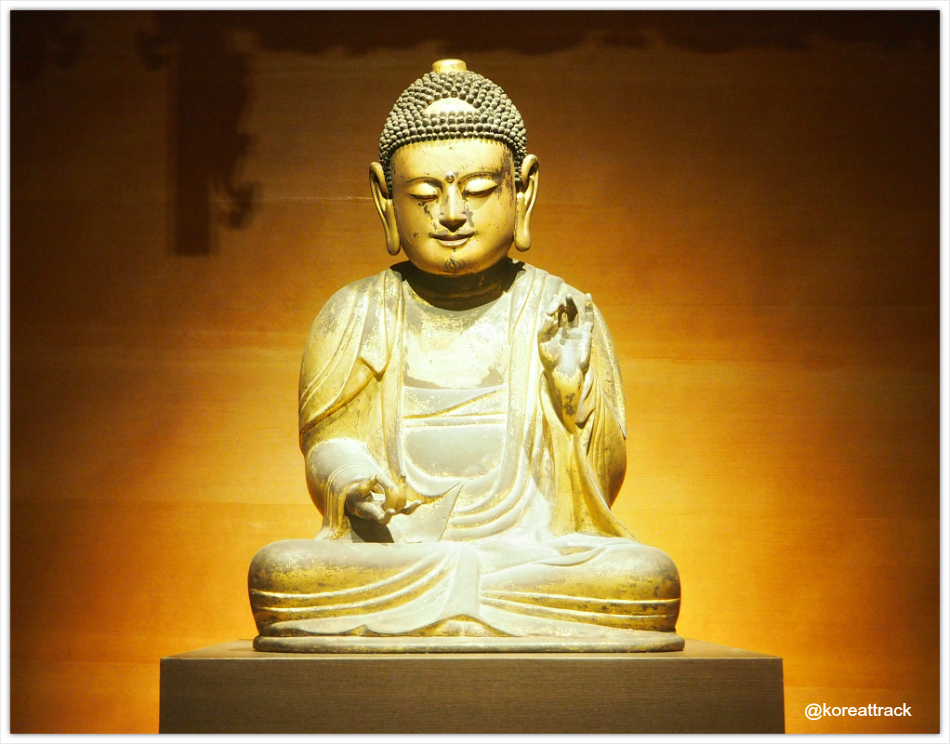
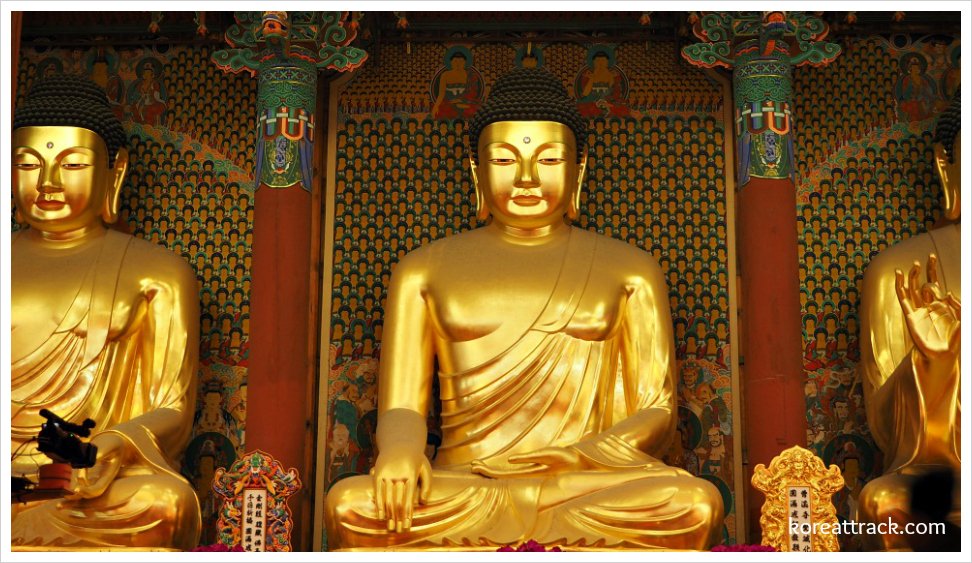
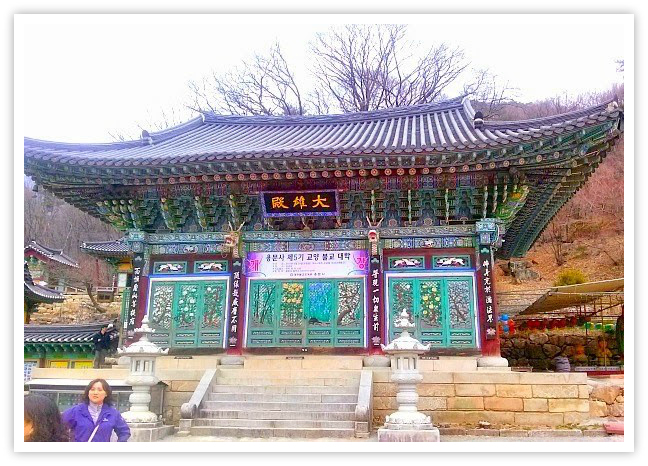




New! Comments
What do you think about this page? Leave me a comment in the box below.